Related Research Articles

Fortified wine is a wine to which a distilled spirit, usually brandy, has been added. In the course of some centuries, winemakers have developed many different styles of fortified wine, including port, sherry, madeira, Marsala, Commandaria wine, and the aromatised wine vermouth.

Syrah, also known as Shiraz, is a dark-skinned grape variety grown throughout the world and used primarily to produce red wine. In 1999, Syrah was found to be the offspring of two obscure grapes from southeastern France, Dureza and Mondeuse Blanche. Syrah should not be confused with Petite Sirah, a cross of Syrah with Peloursin dating from 1880.
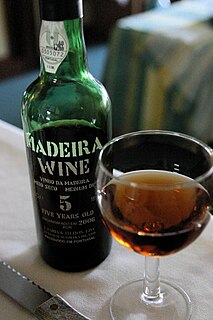
Madeira is a fortified wine made on the Portuguese Madeira Islands, off the coast of Africa. Madeira is produced in a variety of styles ranging from dry wines which can be consumed on their own, as an aperitif, to sweet wines usually consumed with dessert. Cheaper cooking versions are often flavoured with salt and pepper for use in cooking, but these are not fit for consumption as a beverage.
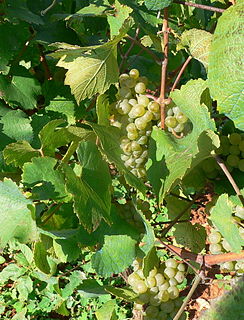
Malvasia is a group of wine grape varieties grown historically in the Mediterranean region, Balearic Islands, Canary Islands and the island of Madeira, but now grown in many of the winemaking regions of the world. In the past, the names Malvasia, Malvazia, and Malmsey have been used interchangeably for Malvasia-based wines; however, in modern oenology, "Malmsey" is now used almost exclusively for a sweet variety of Madeira wine made from the Malvasia grape. Grape varieties in this family include Malvasia bianca, Malvasia di Schierano, Malvasia negra, Malvasia nera, Malvasia nera di Brindisi, Malvasia di Candia aromatica, Malvasia odorosissima, and a number of other varieties.

Sparkling wine is a wine with significant levels of carbon dioxide in it, making it fizzy. While the phrase commonly refers to champagne, EU countries legally reserve that term for products exclusively produced in the Champagne region of France. Sparkling wine is usually either white or rosé, but there are examples of red sparkling wines such as the Italian Brachetto, Bonarda and Lambrusco, and the Australian sparkling Shiraz. The sweetness of sparkling wine can range from very dry brut styles to sweeter doux varieties.
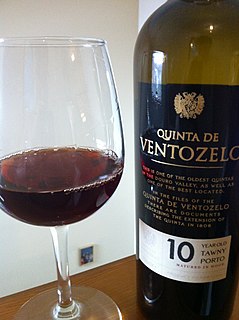
Port wine is a Portuguese fortified wine produced in the Douro Valley of northern Portugal. It is typically a sweet red wine, often served as a dessert wine, although it also comes in dry, semi-dry, and white varieties.

Alicante Bouschet or Alicante Henri Bouschet is a wine grape variety that has been widely cultivated since 1866. It is a cross of Petit Bouschet and Grenache. Alicante is a teinturier, a grape with red flesh. It is one of the few teinturier grapes that belong to the Vitis vinifera species. Its deep colour makes it useful for blending with light red wine. It was planted heavily during Prohibition in California for export to the East Coast. Its thick skin made it resistant to rot during the transportation process. The intense red color was also helpful for stretching the wine during prohibition, as it could be diluted without detracting from the appearance. At the turn of the 21st century, Alicante Bouschet was the 12th most planted red wine grape in France with sizable plantings in the Languedoc, Provence and Cognac regions. In 1958, Alicante Bouschet covered 24,168 hectares ; by 2011, plantings represented less than 4,000 hectares. This scenario is largely reversed in other regions of Europe, and in southern Portugal, where its wines are highly prized and frequently outscore traditional autochthonous varieties.
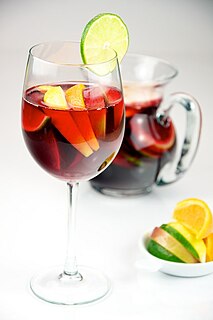
Sangria ; [sɐ̃ˈɡɾi.ɐ] is an alcoholic beverage originating in Spain and Portugal. Under EU regulations only those two Iberian nations can label their product as Sangria; similar products from different regions are differentiated in name.

Tempranillo is a black grape variety widely grown to make full-bodied red wines in its native Spain. Its name is the diminutive of the Spanish temprano ("early"), a reference to the fact that it ripens several weeks earlier than most Spanish red grapes. Tempranillo has been grown on the Iberian Peninsula since the time of Phoenician settlements. It is the main grape used in Rioja, and is often referred to as Spain's noble grape. The grape has been planted throughout the globe's wine regions.

Trousseau or Trousseau Noir, also known as Bastardo and Merenzao, is an old variety of red wine grape originating in eastern France. It is grown in small amounts in many parts of Western Europe; the largest plantations are today found in Portugal, where most famously it is used in port wine. It makes deep cherry red wines with high alcohol and high, sour candy acidity, and flavours of red berry fruits, often complemented - depending on production - by a jerky nose and an organic, mossy minerality.
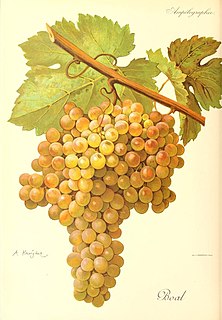
Boal is a name given to several varieties of grape cultivated in Portugal, notably in the production of medium-rich fortified wines from Madeira Island. On many wine labels of Madeira wine, the variety's name is anglicized as Bual. Madeira from Bual is typically less sweet than that from Malmsey, but more sweet than Sercial or Verdelho. The vines are also common in Portugal and Spain, where the fruit is used in the same way for fortified wines.

Portuguese wine is the result of traditions introduced to the region by ancient civilizations, such as the Phoenicians, Carthaginians, Greeks, and mostly the Romans. Portugal started to export its wines to Rome during the Roman Empire. Modern exports developed with trade to England after the Methuen Treaty in 1703. From this commerce a wide variety of wines started to be grown in Portugal. And, in 1758, one of the first wine-producing regions of the world, the Região Demarcada do Douro was created under the orientation of Marquis of Pombal, in the Douro Valley. Portugal has two wine-producing regions protected by UNESCO as World Heritage: the Douro Valley Wine Region and Pico Island Wine Region. Portugal has a big variety of local kinds, producing a very wide variety of different wines with distinctive personality.
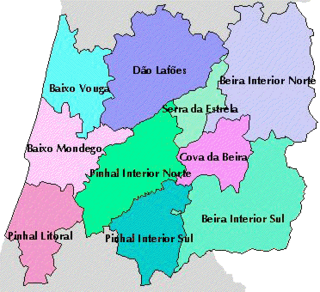
Dão is a Portuguese wine region situated in the Região Demarcada do Dão with the Dão-Lafões sub region of the Centro, Portugal. It is one of the oldest established wine regions in Portugal. Dão wine is produced in a mountainous region with a temperate climate, in the area of the Rio Mondego and Dão rivers in the north central region of Portugal. The region became a Denominação de Origem Controlada (DOC) appellation in 1990. The Dão region is the origin of the Touriga Nacional vine that is the principal component of port wine.

Mencía, known as Jaen in Portugal, is a Spanish grape variety primarily found in the northwestern part of the country. It is planted on over 9,100 hectares, and it is primarily found in the Bierzo, Ribeira Sacra, Valdeorras and Monterrei regions.
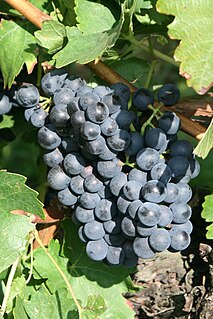
Blauer Portugieser is a red Austrian, Slovenian wine and German wine grape found primarily in the Rheinhessen, Pfalz and wine regions of Lower Austria and Slovenia. It is also one of the permitted grapes in the Hungarian wine Egri Bikavér. In Germany, the cultivated area covered 4,551 hectares or 4.5% of the total vineyard area in 2007. Wine cellars usually vinify a simple light red wine, which is characterized by a fresh, tart and light body. It is also frequently vinified as a rosé. Blauer Portugieser is also very well suited as table grapes; however, it is not sold as such because the selling of wine grapes as table grapes is not permitted in the European Union. Since 2000, higher quality wines have been vinified from Portugieser grapes. The use of oak provides additional aromas in order to compete with Bordeaux varieties. DNA profiling has shown that Blauer Portugieser is a cross between Grüner Silvaner and Blaue Zimmettraube. Historical ampelographic sources have provided very solid evidence that the geographic area of origin of the variety is Lower Styria.
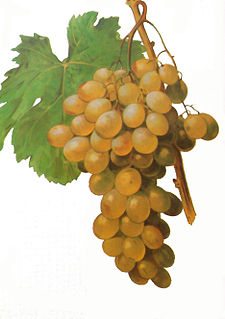
Muscat of Alexandria is a white wine grape that is a member of the Muscat family of Vitis vinifera. It is considered an "ancient vine", and wine experts believe it is one of the oldest genetically unmodified vines still in existence. The grape originated in North Africa, and the name is probably derived from its association with Ancient Egyptians who used the grape for wine making. It is also a table grape used for eating and raisins.
The classification of wine can be done according to various methods including place of origin or appellation, vinification methods and style, sweetness and vintage, or variety used. Practices vary in different countries and regions of origin, and many practices have varied over time. Some classifications enjoy official protection by being part of the wine law in their country of origin, while others have been created by, for example, grower's organizations without such protection.

Although viticulture and the cultivation of grapes for table consumption has a long history in Japan, domestic wine production using locally produced grapes only really began with the adoption of Western culture during the Meiji restoration in the second half of the 19th century.

The modern Indian Wine market is small but growing; annual per capita consumption of wine in the country is a mere 9 milliliters, approximately 1/8000th that of France. The main reason for this can be attributed to the fact that Indians preference for hard liquor and beer boasts nearly 98% of market share whereas wine with low ABV only has 2% market share. The Viticulture in India has a long history dating back to the time of the Indus Valley civilization when grapevines were believed to have been introduced from Persia. Winemaking has existed throughout most of India's history but was particularly encouraged during the time of the Portuguese and British colonization of the subcontinent. The end of the 19th century saw the phylloxera louse take its toll on the Indian wine industry followed by religious and public opinion moving towards the prohibition. Following the country's independence from the British Empire, the government encouraged vineyards to convert to table grape and raisin production. In the 1980s and 1990s, a revival in the Indian wine industry took place as international influences and the growing middle class started increasing demand for the beverage. By the turn of the 21st century, demand was increasing at a rate of 20-30% a year. The city of Nashik in the state of Maharashtra is called the "Wine Capital of India."
Azal branco is a white Portuguese wine grape planted primarily in the Minho region but with greater expansion to Amarante, Basto, Baião and Vale do Sousa sub-regions. It noted for the high acidity of its wines, and is used for white Vinho Verde. Varietal Azal Branco wines can be somewhat reminiscent of Riesling.
References
- ↑ J. Robinson (ed) "The Oxford Companion to Wine" Third Edition pg 191 Oxford University Press 2006 ISBN 0-19-860990-6